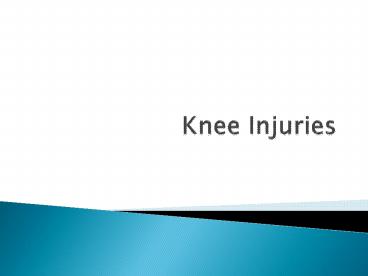Knee Injuries - PowerPoint PPT Presentation
1 / 17
Title:
Knee Injuries
Description:
Hinge joint at the articulation (point of contact) of 3 bones Stabilized by 4 major ligaments, cartilage, and strong musculature Knee also able to rotate 3 bones form ... – PowerPoint PPT presentation
Number of Views:379
Avg rating:3.0/5.0
Title: Knee Injuries
1
Knee Injuries
2
Anatomy of the knee
- Hinge joint at the articulation (point of
contact) of 3 bones - Stabilized by 4 major ligaments, cartilage, and
strong musculature - Knee also able to rotate
3
Bones of the knee
- 3 bones form the knee joint
- Femur, tibia, fibula
- Primary movement occurs at the POC of the tibia
and femur - Patella sesamoid (floating bone)
- As the knee flexes and extends, the patella
glides up and down on the front of the femur
4
Ligaments
- 4 primary knee ligaments
- Medial collateral ligament (MCL)-provides
stability to the inside (medial) aspect of knee - Lateral collateral ligament (LCL)-helps stabilize
outside (lateral) aspect
5
Ligaments
- Anterior cruciate ligament (ACL)-keeps tibia from
moving forward on the femur - Posterior cruciate ligament (PCL)-prevents tibia
from moving backward on femur - PCL and ACL pass thru the middle of the knee
joint and cross each other
6
Cartilage (menisci)
- Ends of tibia and femur are covered and cushioned
by pieces of tough cartilage tissue called
menisci - Without menisci, tibia and femur would rub
against each other, causing the bones to wear
down quickly - Menisci also help stabilize the joint
7
Muscles
- Provide movement and stability
- Primary muscles include hamstring group and
quadricep group - Knee extension primarily performed by the quads
(4 muscles) - Knee flexion performed by the hamstrings (3
muscles)
8
Preventing Knee Injuries
- Ligament sprains are the most common injuries at
the knee - Athletes should develop strength in the muscles
around the knee - If athlete has problems with knees, ATC should
examine leg structure to determine if he/she has
genu valgus (knock-knees) or genu varus (bowlegs)
9
Treating Knee Injuries
- Knee vulnerable to injuries due to exposure to
many forces - Ligaments extremely vulnerable but tendon and
bone injuries do occur
10
Ligament Injuries
- ACL-athlete often disabled, complaining of knee
giving way, collapsing, and popping - Often the most serious and most frequently
surgically reconstructed - Often injured as athlete attempts to change
directions quickly and twists lower leg - May hear a popping sound
- Immediate treatment includes PRICE, knee
immobilizer, and crutches - Rehab focuses on strengthening hamstrings to help
stabilize tibia
11
PCL injuries
- Frequently injured when athlete falls and bent
knee bears full weight, when knee is forcefully
hyperflexed or blow is delivered to the front of
the tibia - Often little swelling
- Treatment includes PRICE and referral to physican
- Rehab focuses on strengthening the quads and
regaining full function
12
MCL injuries
- Injured when athlete receives a blow to the
outside of the knee - Treatment includes PRICE
- Moderate to severe MCL needs an immobilizer
- Rehab focuses on strengthening the muscles that
cross the medial aspect of the knee
13
Degrees of MCL sprains
- Mild MCL sprain-medial joint line pain, little if
any swelling, no joint laxity, full flexion and
extension - Moderate MCL sprain-mild swelling, discomfort,
some joint laxity - Severe MCL sprain-moderate or severe swelling,
loss of function, great deal of joint laxity
14
LCL injuries
- Occur less frequently than MCL injuries
- Symptoms are similar except discomfort is at the
lateral aspect - Treatment same as MCL
- Rehab focuses on strengthening the lateral thigh
muscles and hamstrings
15
Muscle and Tendon Injuries
- Patellar tendinitis-overuse disorder
characterized by quad weakness and tenderness
over patellar tendon - Treatment will attempt to control inflammation
(apply ice, modify activity level) - Rehab will address flexibility problems or
weakness of the leg
16
Patellar-Femoral Syndrome
- Set of symptoms that include pain and discomfort
around the patella - As the knee bends, instead of riding smoothly,
the patella is grated across the femur, causing
cartilage on the back of the patella to soften or
wear away - Athlete reports a grinding sensation with flexion
and extension - Grinding can be felt by placing hand over patella
- Treatment involves correcting patellar tracking
problems
17
Patella Dislocation
- Patella forced to the lateral aspect of the knee
- Occurs when knee is bent and forced to twist
inward - Athlete is often in distress
- Only physician should reduce a dislocated patella
- Treatment involves immobilizing the knee

